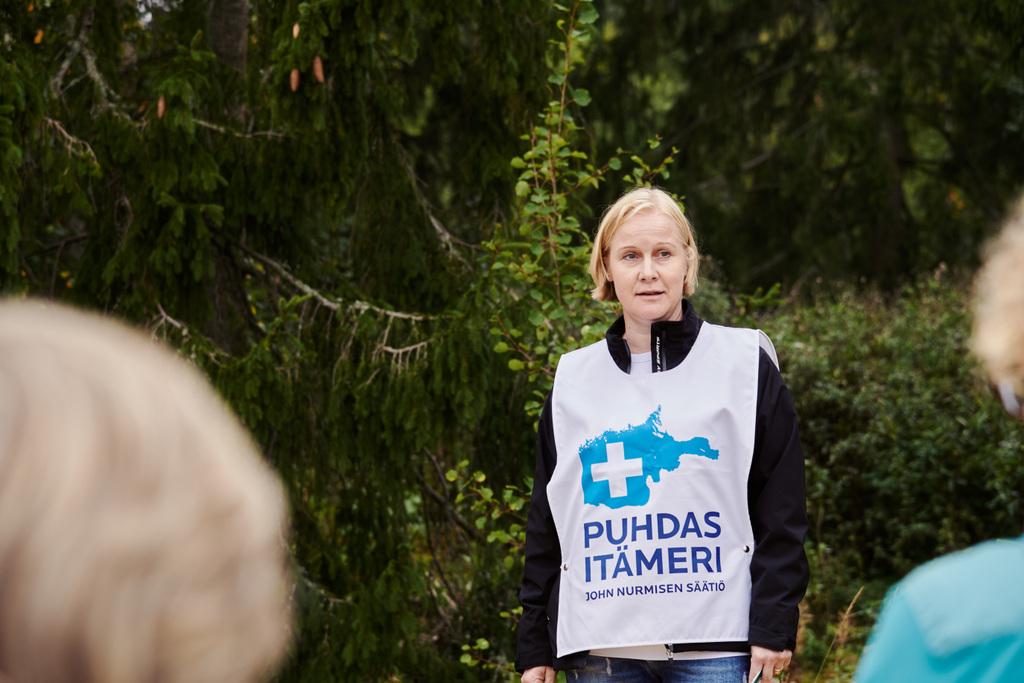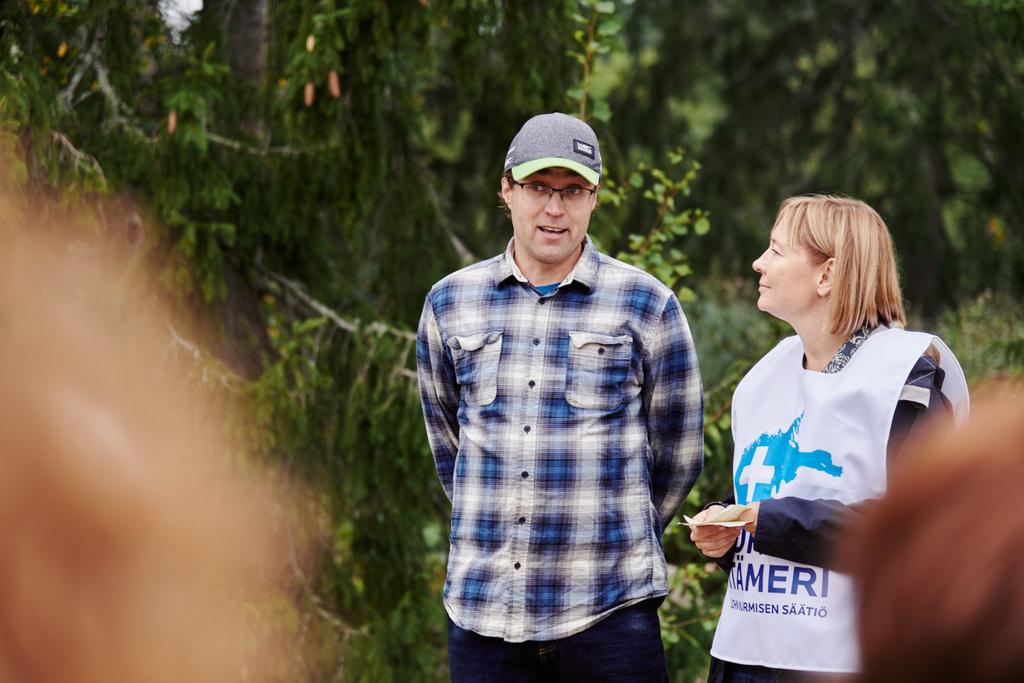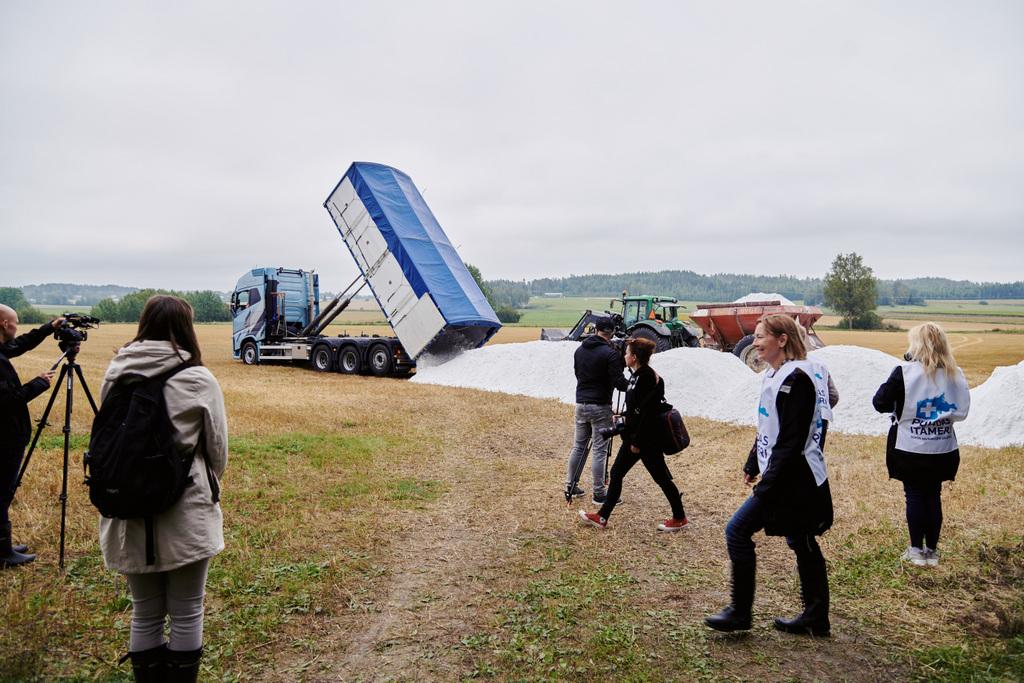‘But the researchers presented us with indisputable facts, leaving us at a loss for words.’
Blog authors Anna Saarentaus, Project Manager for the John Nurminen Foundation’s Clean Baltic Sea projects, and Marjukka Porvari, Clean Baltic Sea Project Director, tell us why the Foundation went full steam ahead with gypsum treatment promotion.
We at the Foundation experienced our first gypsum crush in the autumn of 2014. This did not happen overnight, nor was it love at first sight. Quite often, people come to the Foundation presenting various water protection methods that are supposed to save the Baltic Sea from the predicament it is in. The world is full of ideas, and we welcome them all, but at the same time we are apply mercilessly strict criteria in our choices: there simply has to be scientific evidence on nutrient reduction, acquired on real-life scale. The reduction has to be significant, and the proposed measures cost-efficient and easy to implement.
We actually did not believe that such measures could be found for reducing the load from agriculture, especially if the measures were also meant to reduce that blue-green algae delicacy, dissolved phosphorus. But the researchers presented us with indisputable facts, leaving us at a loss for words. An immediate reduction of approximately 50% in the phosphorus runoff from fields, part of it consisting of dissolved phosphorus; a significant reduction in solids runoff; and implementation with a low-cost waste raw-material, which can be found in abundance in Siilinjärvi. And all of this scientifically proven with over ten years of research and testing, using the scale of a cultivated field!
Earlier in 2005, when we worked with point loads, we had managed to curb several tonnes from the annual phosphorus load of the Gulf of Finland through our projects at the St. Petersburg wastewater treatment plant and the fertilizer factory by the River Luga. We had already managed to clear up the Gulf of Finland somewhat, but in the inner areas of the Archipelago Sea, which for many equals the most beautiful part of Finland, our measures were not sufficient for improving the status of the sea. In this area, the largest individual factor is our own agriculture.
‘This is wild!’ we thought, when presented with the idea that we could clear up our beloved Archipelago Sea, and went to work with the fierceness of a terrier, as was our style already with the St. Petersburg projects. Upon the request of the researchers, we began pushing the idea of a major scale gypsum pilot. In the spring of 2015, we met with the leaders of the Central Union of Agricultural Producers and Forest Owners (MTK) and the Swedish-speaking agricultural union SLC, the then ministers for agriculture and the environment, and the representatives of all parliamentary groups who would meet us. We wrote to newspapers and members of parliament, and spread the gospel on this opportunity to save the Archipelago Sea like true eager beavers. At the same time, we included gypsum treatment as one of the concrete pilot measures into the NutriTrade project that was then being planned.
In the autumn of 2015 came the happy moment when we heard that our persistence had paid off: gypsum treatment would be implemented with two projects pitching in, in Lieto in Southwest Finland, and in Paimio in the Savijoki catchment area! First, the Interreg Central Baltic programme had granted funding for gypsum treatment as a part of the NutriTrade project. Then, the government had included it in one of its key projects, and the SAVE project thus created received financing via the Ministry of the Environment.

The experiment conducted in an area of over 1,500 hectares in Southwest Finland showed clearly that gypsum was not an infatuation that would quickly pass: the conclusion continues to be that gypsum curbs 50% of the phosphorus runoff of the fields; is extremely efficient in reducing erosion and solids runoff, and is, for these reasons, just as cost-efficient as we had thought. The gypsum pilot proved that in terms of logistics, for example, this measure can be implemented efficiently also in practice, and that farmers find it easy to implement, and a worthwhile measure. Moreover, we received important data on the fact that gypsum does not have harmful side-effects on aquatic fauna.

The results convinced us that we should expand our gypsum crush to nation-wide operations, spanning all of the southern and western coasts. In addition to having the character of a terrier, we at the Foundation are also extremely impatient when it comes to the Baltic Sea – if we want to save it, there is no time to waste. This is why the idea of expanding gypsum treatment only when the next EU subsidy period commences, maybe in 2022-2023 and depending on delays caused by Brexit, was for us simply dreadful. What we decided to do instead was launch a private gypsum treatment project immediately when the final results of the project in southwest Finland were finalised in spring 2018. As our project site, we selected the River Vantaa, an area that is very important for the recreational use of millions of people. We also decided to double the hectares of the pilot in southwest Finland up to at least 3,000 hectares, which greatly reduces the runoff via the River Vantaa to Vanhankaupunginlahti and the Gulf of Finland.
In the winter of 2018, we contacted our potential private supporters. Our visit to the Ministry of the Environment in January 2018 resulted in a wonderful surprise, when we heard that public funding might also be available for the gypsum treatment of the fields of the River Vantaa.
So now, ladies and gentlemen, after lots of hard work, we are proud to present the little sister of the SAVE project: the Vantaanjoki gypsum project, funded privately and with public funds, was officially born on 28 June (see press release on the Vantaanjoki gypsum project). Our funding was strong enough to enable us to spread gypsum on nearly 3,500 hectares of fields by the River Vantaa!
In addition to the Foundation, partners in the Vantaanjoki Gypsum Project include the Water Protection Association of the River Vantaa and the Helsinki Region, the University of Helsinki, and the Finnish Environment Institute. We have concluded agreements on spreading gypsum with 23 farmers in 2018. These agreements cover 1,080 hectares. Next year, we will move ahead with more than double the hectares of this year.

The gypsum is brought directly to the field with a truck from Siilinjärvi, and spread with the same equipment used for spreading calcium, at the time of autumn sowing.
In addition to spreading gypsum, our work plan also includes monitoring the quality of the water, conducting research on the fish stock, and fieldside events. We hope to receive support in the effort to save the river Vantaa also from the general public, and have launched a crowd funding campaign for the project. Every €100 donated to the project increases the area to be treated with gypsum by almost half a hectare, and reduces the phosphorus load by 1.4 kg. Can there be a more concrete way to protect the waterways close by, and also the Baltic Sea, than treating a half hectare field of your own with gypsum!? …… and that is not all. Another stakeholder in our project is Porvoon vesi, which decided to offset its nutrient footprint by supporting the gypsum treatment of fields (see press release on the gypsum treatment of fields in the Porvoonjoki area.) With this donation, the gypsum pilot gained another little sister, the Porvoonjoki Gypsum Project. Five farmers from Porvoo joined in with a total field area of 73 hectares.
Our initial crush has therefore turned out to be permanent in nature, giving birth to two new gypsum projects already. Our sincere wish is that in the budget negotiations of next autumn, our family will grow with more siblings, and gypsum treatment will expand fast, becoming a nation-wide measure in all of southern and western Finland. In our dreams, we can already see the blue glimmer of the river waterways and a Baltic Sea that is clearing up!
This blog is first released on the pages of the SAVE research project. The project for improving water quality in the Archipelago Sea through treating fields with gypsum (SAVE) investigates how applicable gypsum is for improving the status of the Archipelago Sea and the entire Baltic Sea.
Photos in the blog were taken at the Myyrinmaa farm, at the fieldside event of 5 September 2018. Photography: Ilkka Vuorinen 7

